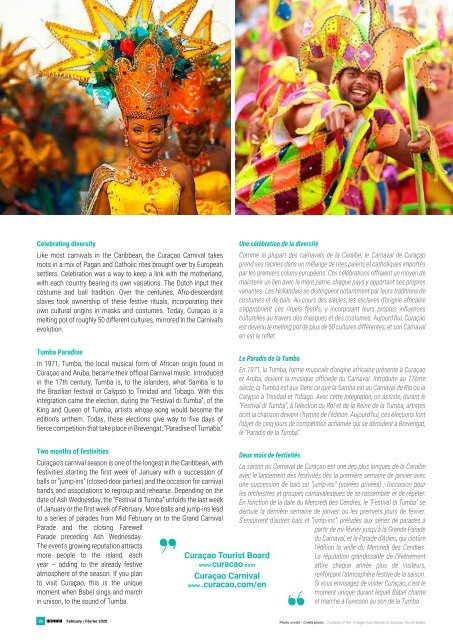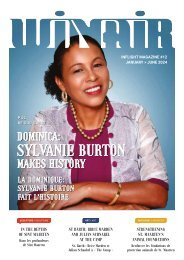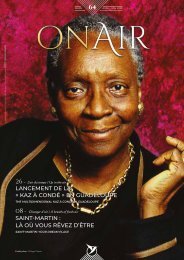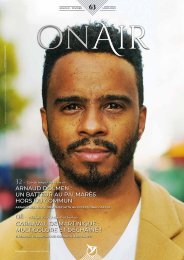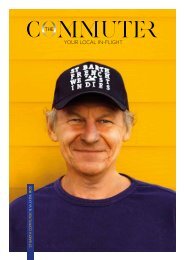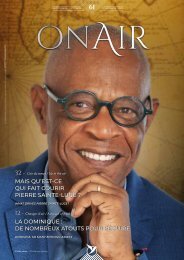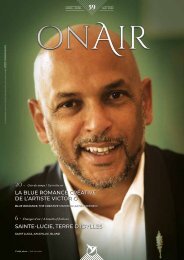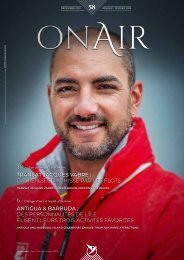Winair#09
You also want an ePaper? Increase the reach of your titles
YUMPU automatically turns print PDFs into web optimized ePapers that Google loves.
Celebrating diversity<br />
Like most carnivals in the Caribbean, the Curaçao Carnival takes<br />
roots in a mix of Pagan and Catholic rites brought over by European<br />
settlers. Celebration was a way to keep a link with the motherland,<br />
with each country bearing its own variations. The Dutch input their<br />
costume and ball tradition. Over the centuries, Afro-descendant<br />
slaves took ownership of these festive rituals, incorporating their<br />
own cultural origins in masks and costumes. Today, Curaçao is a<br />
melting pot of roughly 50 different cultures, mirrored in the Carnival’s<br />
evolution.<br />
Tumba Paradise<br />
In 1971, Tumba, the local musical form of African origin found in<br />
Curaçao and Aruba, became their official Carnival music. Introduced<br />
in the 17th century, Tumba is, to the islanders, what Samba is to<br />
the Brazilian festival or Calypso to Trinidad and Tobago. With this<br />
integration came the election, during the “Festival di Tumba”, of the<br />
King and Queen of Tumba, artists whose song would become the<br />
edition’s anthem. Today, these elections give way to five days of<br />
fierce competition that take place in Brevengat, “Paradise of Tumaba.”<br />
Une célébration de la diversité<br />
Comme la plupart des carnavals de la Caraïbe, le Carnaval de Curaçao<br />
prend ses racines dans un mélange de rites païens et catholiques importés<br />
par les premiers colons européens. Ces célébrations offraient un moyen de<br />
maintenir un lien avec la mère patrie, chaque pays y apportant ses propres<br />
variantes. Les Hollandais se distinguent notamment par leurs traditions de<br />
costumes et de bals. Au cours des siècles, les esclaves d’origine africaine<br />
s’approprient ces rituels festifs, y incorporant leurs propres influences<br />
culturelles au travers des masques et des costumes. Aujourd’hui, Curaçao<br />
est devenu le melting pot de plus de 50 cultures différentes, et son Carnaval<br />
en est le reflet.<br />
Le Paradis de la Tumba<br />
En 1971, la Tumba, forme musicale d’origine africaine présente à Curaçao<br />
et Aruba, devient la musique officielle du Carnaval. Introduite au 17ème<br />
siècle, la Tumba est aux îliens ce que la Samba est au Carnaval de Rio ou la<br />
Calypso à Trinidad et Tobago. Avec cette intégration, on assiste, durant le<br />
“Festival di Tumba”, à l’élection du Roi et de la Reine de la Tumba, artistes<br />
dont la chanson devient l’hymne de l’édition. Aujourd’hui, ces élections font<br />
l’objet de cinq jours de compétition acharnée qui se déroulent à Brevengat,<br />
le “Paradis de la Tumba”.<br />
Two months of festivities<br />
Curaçao’s carnival season is one of the longest in the Caribbean, with<br />
festivities starting the first week of January with a succession of<br />
balls or “jump-ins” (closed-door parties) and the occasion for carnival<br />
bands and associations to regroup and rehearse. Depending on the<br />
date of Ash Wednesday, the “Festival di Tumba” unfolds the last week<br />
of January or the first week of February. More balls and jump-ins lead<br />
to a series of parades from Mid February on to the Grand Carnival<br />
Parade and the closing Farewell<br />
Parade preceding Ash Wednesday.<br />
The event’s growing reputation attracts<br />
more people to the island, each<br />
year – adding to the already festive<br />
atmosphere of the season. If you plan<br />
to visit Curaçao, this is the unique<br />
moment when Babel sings and march<br />
in unison, to the sound of Tumba.<br />
Deux mois de festivités<br />
Curaçao Tourist Board<br />
www.curacao.com<br />
Curaçao Carnival<br />
www..curacao.com/en<br />
La saison du Carnaval de Curaçao est une des plus longues de la Caraïbe<br />
avec le lancement des festivités dès la première semaine de janvier avec<br />
une succession de bals ou “jump-ins” (soirées privées) ; l’occasion pour<br />
les orchestres et groupes carnavalesques de se rassembler et de répéter.<br />
En fonction de la date du Mercredi des Cendres, le “Festival di Tumba” se<br />
déroule la dernière semaine de janvier ou les premiers jours de février.<br />
S’ensuivent d’autres bals et “jump-ins”, préludes aux séries de parades à<br />
partir de mi-février jusqu’à la Grande Parade<br />
du Carnaval, et la Parade d’Adieu, qui clotûre<br />
l’édition la veille du Mercredi des Cendres.<br />
La réputation grandissante de l’événement<br />
attire chaque année plus de visiteurs,<br />
renforçant l’atmosphère festive de la saison.<br />
Si vous envisagez de visiter Curaçao, c’est le<br />
moment unique durant lequel Babel chante<br />
et marche à l’unisson au son de la Tumba.<br />
26 February / Février 2020<br />
Photo credit - Crédit photo: Courtesy of the - Images fournies par le Curaçao Tourist Board


